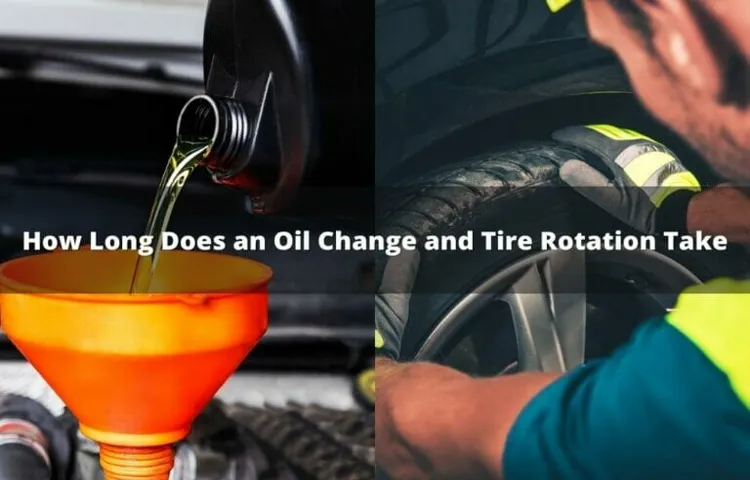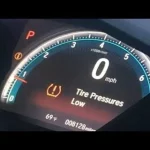If you’re like many vehicle owners, you’ve likely asked yourself, “how long does it take for an oil change and tire rotation?” It’s a valid question, especially when your schedule is tight, and you need to arrange for routine maintenance. The good news is that the process isn’t all that time-consuming, but the exact timing can vary depend on a few factors. Oil changes are one of the most crucial routine maintenance tasks you can do for your car.
They help keep your engine running smoothly and prevent costly repairs down the road. As for the time it takes, it’s generally a straightforward process that shouldn’t take too long, provided no complications arise. Tire rotations, on the other hand, are less frequent but equally important to maintain proper vehicle performance.
They help prolong the life of your tires and promote even wear, reducing the chances of expensive replacements. The process involves moving your tires from one position to another, so the wear is evened out. Like oil changes, the length of time it takes for tire rotations is pretty quick and can usually be done in the same timeframe as the oil change.
While it’s understandable to want to know how long an oil change and tire rotation will take, they’re both essential to maintaining your car’s health. Skipping them could lead to costly repairs or even worse safety issues. Instead, plan to set aside a bit of time for the maintenance so you can keep your vehicle running its best for years to come.
Table of Contents
Overview of Oil Change and Tire Rotation Services
If you’re wondering how long an oil change and tire rotation takes, it all depends on the service provider and the level of expertise they possess. Usually, an oil change takes about 20-30 minutes, which is relatively quick and shouldn’t interfere too much with your day. A tire rotation usually takes around the same time, depending on the number of tires that need to be rotated.
However, it’s always a good idea to schedule an appointment in advance and have an estimation provided by the technician. Both of these services are essential in prolonging the life of your vehicle and maintaining its optimal performance. Regular oil changes will ensure that your engine runs smoothly and efficiently and also helps to keep the internal combustion clean.
Regular tire rotations will prevent the tires from wearing unevenly and will ensure that they last longer. Overall, taking care of your car through regular maintenance is a great way to avoid expensive repairs in the future.
What is an Oil Change?
An oil change is a simple yet crucial maintenance service to keep your vehicle running smoothly. It involves draining the old oil from your engine and replacing it with fresh, clean oil. This process helps to lubricate the engine’s moving parts, prevent friction, and remove particles that accumulate over time.
Regularly changing your oil can improve performance, increase fuel efficiency, and extend the life of your engine. Along with oil changes, tire rotation services are also essential to maintain the condition of your tires. Tire rotation involves moving each tire to a different position on your vehicle to ensure even wear and tear.
This helps to prolong the life of your tires and prevent risks of blowouts or accidents on the road. Overall, keeping up with routine oil changes and tire rotations can save you money in the long run and keep your vehicle in top shape.

What is a Tire Rotation?
When it comes to vehicle maintenance, there are certain services that need to be done regularly to ensure optimal performance and lifespan of your car. Two important services are oil change and tire rotation. While an oil change involves replacing the used oil with new oil to keep the engine lubricated and running smoothly, a tire rotation involves moving the tires to different positions on the vehicle to ensure even wear and tear.
This ensures that the tires last longer and the vehicle’s handling and grip remain consistent. During a tire rotation, the front tires may be moved to the back, and vice versa, while the left and right sides may also be swapped. It is best to have this service performed every 5,000 to 7,500 miles or as recommended by your vehicle’s manufacturer.
By keeping up with these regular services, you can help extend the life of your car and save yourself from unexpected breakdowns and repairs.
Factors that Affect the Time it Takes
When it comes to getting an oil change and tire rotation, the time it takes can vary depending on a few different factors. First and foremost, the type of vehicle you have can affect the time it takes, as some cars are more complex than others and require more time to complete the task. Additionally, the condition of your vehicle and the quality of the oil and tires can also play a role.
If your vehicle is in poor condition or the oil and tires need special attention, it may take longer to complete the maintenance. Lastly, the location and availability of the service center can also play a part in determining how long it will take. While some centers may be able to accommodate same-day service, others may require you to schedule an appointment in advance.
Overall, it’s important to factor in these variables when planning for an oil change and tire rotation so that you can budget your time accordingly.
Type of Vehicle
When it comes to shipping your belongings, the type of vehicle used can greatly affect the time it takes for your items to reach their destination. For example, if you are shipping a large quantity of items, a truck may be the best option, as it can fit more items than a car or van. However, if you need your items to arrive quickly, a plane may be a better choice, as it can cover long distances in a short amount of time.
The size of the vehicle will also impact the speed of delivery, as smaller vehicles may have to make more trips to transport all of your belongings. Additionally, the route taken by the vehicle will play a role in how long it takes for your items to arrive. Factors such as traffic and weather conditions can cause delays, so it is important to consider these variables when selecting a shipping method.
Overall, it is important to carefully evaluate the different types of vehicles available and select the one that best fits your needs in terms of timing and quantity.
Type of Oil and Filters Used
When it comes to changing the oil and filters in your car, there are several factors that can affect the amount of time it takes to perform the task. One key factor is the type of oil and filters used. For example, synthetic oil tends to last longer than conventional oil, which means you may not need to change it as frequently.
On the other hand, some filters may be easier to access and replace than others, which can reduce the amount of time needed for an oil change. Other factors that can impact the time it takes to change your oil and filters include the make and model of your vehicle, the condition of the parts being replaced, and the experience level of the person performing the maintenance. It’s always a good idea to consult your owner’s manual or a professional mechanic for guidance on how long an oil change should take for your specific vehicle and to ensure that the job is done properly.
In summary, the type of oil and filters used can have a significant impact on the time it takes to change your vehicle’s oil, but there are other factors to consider as well.
Number of Technicians Working on the Vehicle
When it comes to getting your vehicle repaired, one of the most significant factors that can affect the time it takes to complete the job is the number of technicians working on it. Typically, the more technicians there are working on a vehicle, the faster the repairs can be completed. This is because more hands mean that more tasks can be completed simultaneously.
However, it’s important to note that the number of technicians needed depends on the complexity of the repairs required. For instance, a simple job like changing the oil or replacing a tire may only require one or two technicians, while more complex jobs like engine repairs or transmission replacements may require a team of technicians. Additionally, the experience and skills of the technicians also play a role in determining how many are needed.
If the technicians are inexperienced or lack the necessary skills, the job may take longer even with more people working on it. Overall, the key is to find the ideal balance between the number of technicians and their capabilities to ensure that the job is done efficiently and effectively.
Average Time for Oil Change and Tire Rotation
When it comes to car maintenance, oil changes and tire rotations are two essential tasks that can help prolong the life of your vehicle. The average time for an oil change and tire rotation varies depending on your car make and model, but generally, an oil change takes about 30 minutes to an hour, while a tire rotation takes about 15-30 minutes. However, it’s important to note that these times can differ depending on the specific service center you go to and the number of customers ahead of you in line.
In addition, some mechanics might take longer if they are doing a thorough inspection of your car during the oil change or rotation. Regardless, it’s always a good idea to schedule regular maintenance appointments to keep your car running smoothly and efficiently. By staying on top of oil changes and tire rotations, you’ll not only increase your car’s performance, but also potentially save money on costly repairs down the road.
Compact Car or Sedan
When it comes to owning a vehicle, it’s important to stay on top of routine maintenance tasks such as oil changes and tire rotations. For both compact cars and sedans, the average time for an oil change is around every 5,000-7,500 miles. However, this can vary depending on the make and model of your vehicle, as well as your driving habits.
Tire rotations are typically recommended every 6,000 miles or so, which helps to ensure even wear and prolong the life of your tires. It’s worth noting that neglecting these routine maintenance tasks can lead to more expensive repairs down the line, so it’s best to stay proactive and stick to a regular maintenance schedule. Whether you drive a compact car or a sedan, proper maintenance can help keep your vehicle running smoothly and save you money in the long run.
SUV or Truck
When it comes to maintaining your SUV or truck, it’s essential to keep up with regular oil changes and tire rotations. These are critical components of keeping your vehicle running smoothly and extending its lifespan. On average, it’s recommended to change your oil every 5,000 miles or every six months, whichever comes first.
This may vary depending on your driving habits and the manufacturer’s recommendations, so it’s important to consult your owner’s manual or a trusted mechanic. As for tire rotations, it’s generally recommended to rotate your tires every 8,000-10,000 miles to ensure even wear. This can also help improve traction and handling and prevent premature tire wear.
In the end, it’s crucial to stay on top of routine maintenance tasks to ensure your SUV or truck remains reliable and safe on the road. So whether you choose an SUV or a truck, make sure to prioritize these important maintenance tasks to keep your vehicle in top shape.
Conclusion
In the grand scheme of things, how long it takes for an oil change and tire rotation may seem trivial, but just like a finely tuned engine, every minute counts. So, whether it’s 30 minutes or an hour, use that time to grab a cup of coffee, read a book or catch up on some small talk with the service staff – they might just rotate your tires a little faster. And remember, a little downtime for maintenance can save you a lot of headaches down the road!”
FAQs
How often should I rotate my tires?
Tire rotation is recommended every 6,000 to 8,000 miles, or every six months – whichever comes first.
How long does an oil change and tire rotation take?
Generally, an oil change and tire rotation takes about an hour to an hour and a half.
Can I just get an oil change without a tire rotation?
Yes, you can get just an oil change without a tire rotation. However, it is recommended to get them done together for optimal vehicle maintenance.
Should I get an alignment with my tire rotation?
It is recommended to get an alignment done at the same time as a tire rotation, but it is not always necessary. Alignment should be done if you notice uneven tire wear or pulling to one side while driving.
How much does an oil change and tire rotation cost?
The cost of an oil change and tire rotation can vary depending on location, type of vehicle, and additional services requested. It is best to contact your local auto shop for an estimate.
How do I know if my tires need to be rotated?
You should rotate your tires if you notice uneven wear, vibrations while driving, or if you have had your tires for more than 6,000 miles.
Do I need to use synthetic oil for my oil change?
It is recommended to use the type of oil specified in the owner’s manual for your vehicle. Synthetic oil may be recommended for some vehicles, but not necessary for all.



